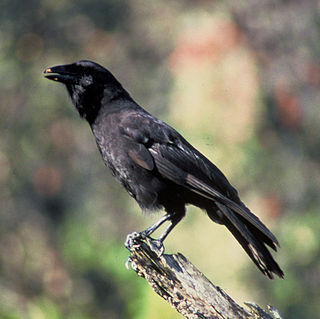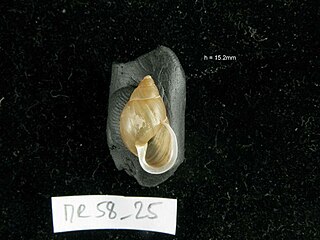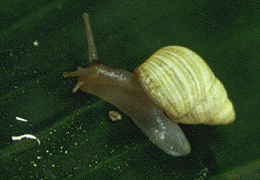
Bora Bora is an island group in the Leeward Islands in the South Pacific. The Leeward Islands comprise the western part of the Society Islands of French Polynesia, which is an overseas collectivity of the French Republic in the Pacific Ocean. Bora Bora has a total land area of 30.55 km2 (12 sq mi). The main island, located about 230 kilometres northwest of Papeete, is surrounded by a lagoon and a barrier reef. In the center of the island are the remnants of an extinct volcano, rising to two peaks, Mount Pahia and Mount Otemanu; the highest point is at 727 m (2,385 ft). Bora Bora is part of the Commune of Bora-Bora, which also includes the atoll of Tūpai. The main languages spoken in Bora Bora are Tahitian and French. However, due to the high tourist population, many natives of Bora Bora have learned to speak English.

Euglandina rosea, the rosy wolfsnail or cannibal snail, is a species of medium-sized to large predatory air-breathing land snail, a carnivorous terrestrial pulmonate gastropod mollusk in the family Spiraxidae.

A species that is extinct in the wild (EW) is one that has been categorized by the International Union for Conservation of Nature as only consisting of living members kept in captivity or as a naturalized population outside its historic range. Classification requires exhaustive surveys conducted within the species' known habitat with consideration given to seasonality, time of day, and life cycle. Once a species is classified as EW, the only way for it to be downgraded is through reintroduction.

Partula dentifera is an extinct species of air-breathing tropical land snail, a terrestrial pulmonate gastropod mollusk in the family Partulidae. This species was endemic to the Raiatea in the Society Islands of French Polynesia, where the last live individual was seen in 1972. It was officially declared extinct by the International Union for Conservation of Nature in June 2024.
Partula dolorosa was a species of air-breathing tropical land snail, a terrestrial pulmonate gastropod mollusk in the family Partulidae. This species was endemic to a highland on Raiatea, French Polynesia. It is now extinct.

Partula faba, commonly known as the bean snail, Partula snail, or Captain Cook's bean snail, is an extinct species of air-breathing tropical land snail, a terrestrial pulmonate gastropod mollusk in the family Partulidae. This species was endemic to Ra'iātea and Tahaa, neighbouring islands which share the same lagoon, in French Polynesia. The species was the first Partula to be recorded.
Partula jackieburchi is an extinct species of tropical, air-breathing land snail, a terrestrial, pulmonate, gastropod mollusk in the family Partulidae.
Partula labrusca, was a species of air-breathing land snail, a terrestrial pulmonate gastropod mollusk in the Partulidae family. This species was endemic in Raiatea, the Society Islands of French Polynesia.
Partula mirabilis, common name the Moorean viviparous tree snail, is a species of air-breathing tropical land snail, a terrestrial pulmonate gastropod mollusk in the family Partulidae. This species was endemic to the island of Moorea, French Polynesia. It is now extinct in the wild.

Partula mooreana, common name the Moorean viviparous tree snail, is a species of air-breathing tropical land snail, a terrestrial pulmonate gastropod mollusk in the family Partulidae. This species was endemic to French Polynesia. It is now extinct in the wild.

Partula rosea is a species of air-breathing tropical land snail, a terrestrial pulmonate gastropod mollusk in the family Partulidae.

Partula suturalis, commonly called the moorean viviparous tree snail or the sutural partula, is a species of air-breathing tropical land snail, a terrestrial pulmonate gastropod mollusk in the family Partulidae. This species was endemic to the island of Moorea, French Polynesia. It is now extinct in the wild. It was previously listed as extinct in the IUCN Red List of Threatened Species, but has been moved to extinct in the wild since 2009. This error was the result of changing taxonomy.

Partula taeniata, common name the Moorean viviparous tree snail, is a species of terrestrial gastropod in the Partulidae family. It is endemic to French Polynesia.

Partula varia is a species of air-breathing tropical land snail, a terrestrial pulmonate gastropod mollusk in the family Partulidae. This species is endemic to Huahine, French Polynesia. It was extinct in the wild. In 2019 the species was reintroduced to the wild on Huahine.

Partula is a genus of air-breathing tropical land snails, terrestrial pulmonate gastropod mollusks in the family Partulidae.
Partula magistri was a species of air-breathing land snail, a terrestrial pulmonate gastropod mollusk in the family Partulidae. It was endemic to the island of Raiatea in the Society Islands of French Polynesia. It is known from a single shell collected in 1992, and no individuals have been found since then.












